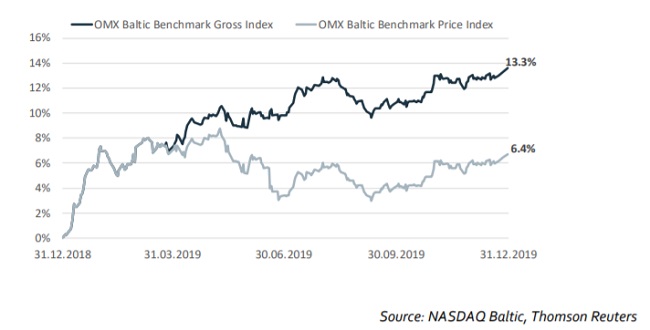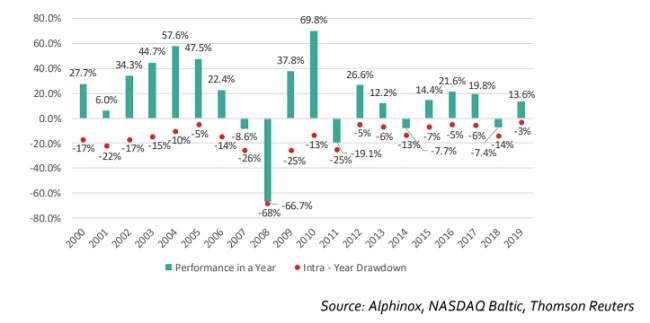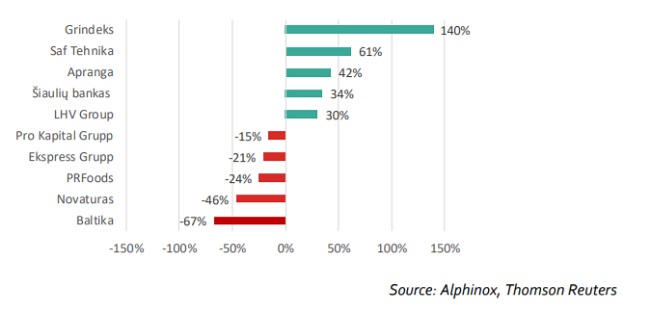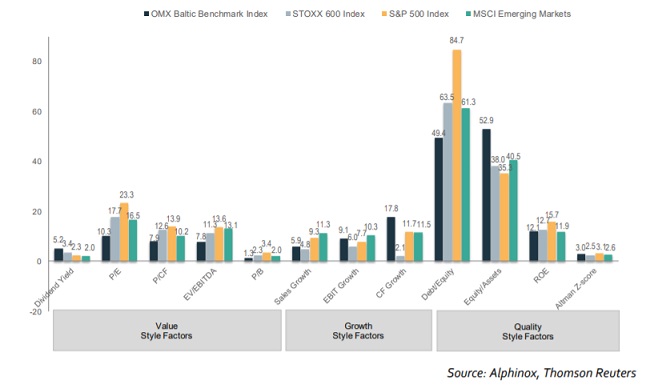Analytics, Baltic, Direct Speech, Exchange, Financial Services
International Internet Magazine. Baltic States news & analytics
Tuesday, 30.12.2025, 11:00
2019 on Baltic Stock Market – the Good, the Bad or the Ugly?
 Print version
Print version
Although 2019 did not bring stellar results to Baltic
investors within a historical perspective, one could have slept well at nights
as volatility was very moderate. On the chart below one can spot that 2019 was
a year with the lowest intra-year drawdown (peak-to-trough decline) of just 3%
over the last two decades. However, we expect the uncertainty around global
economy to increase in 2020, which could lead to higher volatility and,
therefore, higher drawdown.

Many Baltic investors, though possibly happy with
double-digit (13.6% to be precise) total return, might feel envious seeing what
a crazy rally European (STOXX 600 with 23.2%) and US market (S&P 500 index
with 28.9%) have experienced. The main driving force behind this growth
evidently was ongoing loose monetary policy conducted by Federal Reserve and
ECB.

In 2019 Baltic market remained on the sidelines, watching
other markets taking off, but nevertheless still offering attractive dividend
yield of 5.2% and trading at a discount to peers (P/E 10.3).
Tops and flops in Baltics
Grindeks shareholders should have been very happy with a gain of 140% in 2019, with share price rocketing in response to the mandatory share buyback by the major shareholder. Another star was SAF Tehnika – the stock that was badly sold-off in 2018 and partly recovered on positive financial news. Additionally, share price got support from major shareholder Koka Zirgs that acquired some additional free-float shares.
Third best result goes to Apranga, which has also recovered after being
oversold in 2018 and which reported improved financial results thanks to the
significant store count expansion in Riga (newly built shopping mall Akropole
and expansion in Alfa). Apranga’s stock was also supported by major
shareholder that increased its stake.
2019 was quite miserable for Baltika and Novaturas
shareholders. The stock price of both companies continued their negative
performance trend also last year. Baltika marketing brands such as
Monton and Baltman undergo restructuring process in an attempt to survive in a
very competitive apparel industry. Novaturas’ share price drop is caused
by company’s inability to appeal to investors with satisfactory financial
results as competition increases and hot summer also took its toll.

Market with value character
Baltic market clearly is a value market – if compared to the
global equity markets, it has the cheapest valuation on all accounts – P/E,
P/B, P/CF, while the dividend yields are envious. This fact deserves particular
attention at times when one’s idle money yield virtually nothing when kept in
deposits.
Baltic companies are not capable of expanding top line at a
high pace, which is evidenced by rather low sales growth, but they manage to be
efficient, which results into decent growth in operating profit. Another trait
of Baltic companies is conservatism with regard to capital structure: low
interest rates are not an incentive strong enough for the top management to
take on more debt as judged by the levels of Debt to equity and Equity to
Assets. Return on capital makes Baltic companies comparable with their peers
operating in Western Europe and in Emerging markets.

Summarizing it all, there is good fundamental quality of the
Baltic companies and a potential for further growth, which can be unlocked
entering the new decade.
- 25.01.2021 Как банкиры 90-х делили «золотую милю» в Юрмале
- 29.12.2020 В Латвии вводят комендантский час, ЧС продлена до 7 февраля
- 29.12.2020 В Rietumu и в этот раз создали особые праздничные открытки и календари 2021
- 29.12.2020 Latvia to impose curfew, state of emergency to be extended until February 7
- 29.12.2020 Lithuanian president signs 2021 budget bill into law
- 29.12.2020 Президент Литвы утвердил бюджет 2021 года
- 28.12.2020 Рынок недвижимости Эстонии осенью начал быстро восстанавливаться
- 28.12.2020 Tartu to support students' solar car project
- 28.12.2020 New Year Cards and Calendars of Rietumu Bank presented
- 22.12.2020 In 2019, household disposable income in Latvia increased by 6.8%








 «The Baltic Course» Is Sold and Stays in Business!
«The Baltic Course» Is Sold and Stays in Business!

